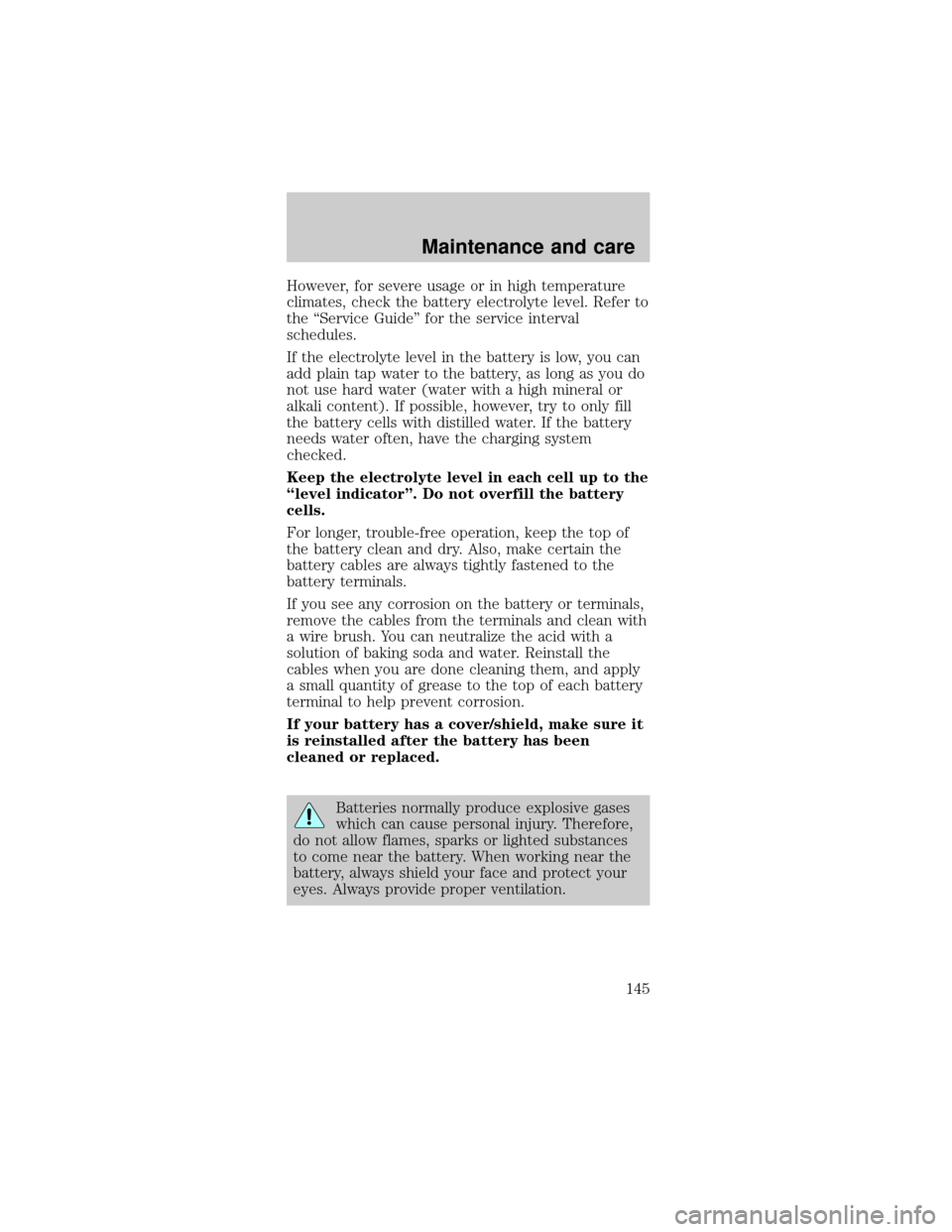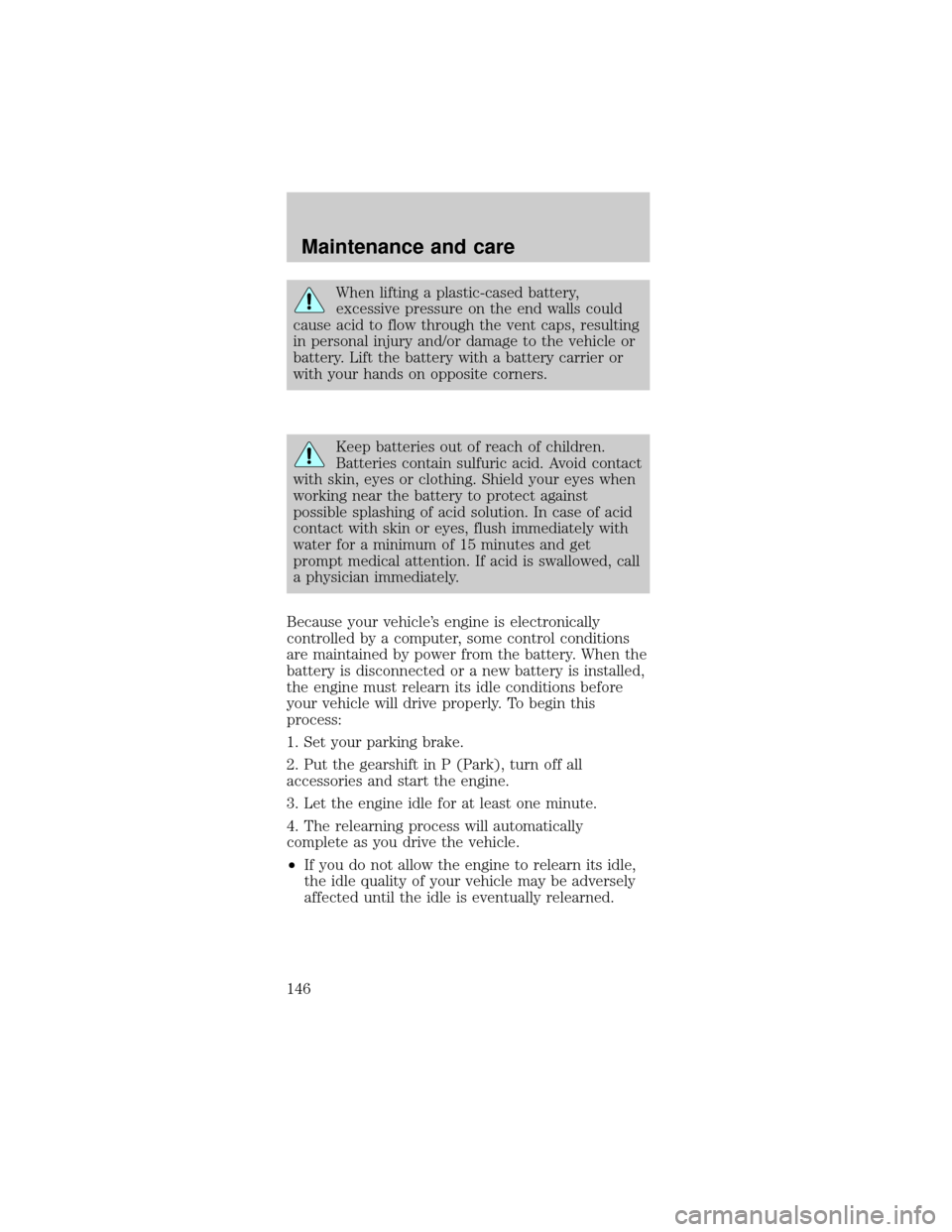Page 145 of 192

However, for severe usage or in high temperature
climates, check the battery electrolyte level. Refer to
the ªService Guideº for the service interval
schedules.
If the electrolyte level in the battery is low, you can
add plain tap water to the battery, as long as you do
not use hard water (water with a high mineral or
alkali content). If possible, however, try to only fill
the battery cells with distilled water. If the battery
needs water often, have the charging system
checked.
Keep the electrolyte level in each cell up to the
ªlevel indicatorº. Do not overfill the battery
cells.
For longer, trouble-free operation, keep the top of
the battery clean and dry. Also, make certain the
battery cables are always tightly fastened to the
battery terminals.
If you see any corrosion on the battery or terminals,
remove the cables from the terminals and clean with
a wire brush. You can neutralize the acid with a
solution of baking soda and water. Reinstall the
cables when you are done cleaning them, and apply
a small quantity of grease to the top of each battery
terminal to help prevent corrosion.
If your battery has a cover/shield, make sure it
is reinstalled after the battery has been
cleaned or replaced.
Batteries normally produce explosive gases
which can cause personal injury. Therefore,
do not allow flames, sparks or lighted substances
to come near the battery. When working near the
battery, always shield your face and protect your
eyes. Always provide proper ventilation.
Maintenance and care
145
Page 146 of 192

When lifting a plastic-cased battery,
excessive pressure on the end walls could
cause acid to flow through the vent caps, resulting
in personal injury and/or damage to the vehicle or
battery. Lift the battery with a battery carrier or
with your hands on opposite corners.
Keep batteries out of reach of children.
Batteries contain sulfuric acid. Avoid contact
with skin, eyes or clothing. Shield your eyes when
working near the battery to protect against
possible splashing of acid solution. In case of acid
contact with skin or eyes, flush immediately with
water for a minimum of 15 minutes and get
prompt medical attention. If acid is swallowed, call
a physician immediately.
Because your vehicle's engine is electronically
controlled by a computer, some control conditions
are maintained by power from the battery. When the
battery is disconnected or a new battery is installed,
the engine must relearn its idle conditions before
your vehicle will drive properly. To begin this
process:
1. Set your parking brake.
2. Put the gearshift in P (Park), turn off all
accessories and start the engine.
3. Let the engine idle for at least one minute.
4. The relearning process will automatically
complete as you drive the vehicle.
²If you do not allow the engine to relearn its idle,
the idle quality of your vehicle may be adversely
affected until the idle is eventually relearned.
Maintenance and care
146
Page 147 of 192
²If the battery has been disconnected or a new
battery has been installed, the clock and the
preset radio stations must be reset once the
battery is reconnected.
²Always dispose of
automotive batteries
in a responsible
manner. Follow your
local authorized
standards for
disposal. Call your
local authorized
authorized recycling center to find out more
about recycling automotive batteries.
CABIN AIR FILTER (IF EQUIPPED)
The cabin air filter restricts the entry of airborne
dust and pollen particles. The filter is located just in
front of the windshield under the cowl vent screen
on the passenger side of the vehicle.
LEAD
RETURN
RECYCLE
Maintenance and care
147
Page 162 of 192

Do not make any unauthorized changes to your
vehicle or engine. By law, vehicle owners and anyone
who manufactures, repairs, items, sells, leases,
trades vehicles, or supervises a fleet of vehicles are
not permitted to intentionally remove an emission
control device or prevent it from working.
Information about your vehicle's emission system is
on the Vehicle Emission Control Information Decal
located on or near the engine. This decal identifies
engine displacement and gives some tune up
specifications.
Please consult your ªWarranty Guideº for complete
emission warranty information.
Readiness for inspection/maintenance (I/M)
testing
In some localities, it may be a legal requirement to
pass an I/M test of the on-board diagnostic (OBD-II)
system. If your ªCheck Engine/Service Engine Soonº
light is on, refer to the description in theWarning
Lights and Chimessection of theInstrumentation
chapter. Your vehicle may not pass the I/M test with
the ªCheck Engine/Service Engine Soonº light on.
If the vehicle's powertrain system or its battery has
just been serviced, the OBD-II system is reset to a
ªnot ready for I/M testº condition. To ready the
OBD-II system for I/M testing, a minimum of 30
minutes of city and highway driving is necessary as
described below:
²First, at least 10 minutes of driving on an
expressway or highway.
²Next, at least 20 minutes driving in stop-and-go,
city-type traffic with at least four idle periods.
Allow the vehicle to sit for at least eight hours
without starting the engine. Then, start the engine
and complete the above driving cycle. The engine
must warm up to its normal operating temperature.
Once started, do not turn off the engine until the
above driving cycle is complete.
Maintenance and care
162
Page 163 of 192

EXTERIOR BULBS
Replacing exterior bulbs
Check the operation of the following lamps
frequently:
²Headlamps
²Tail lamps
²Brakelamps
²High-mount brakelamp
²Turn signals
²Backup lamps
²License plate lamp
Do not remove lamp bulbs unless they will be
replaced immediately. If a bulb is removed for an
extended period of time, contaminants may enter
the lamp housings and affect performance.
Replacing headlamp bulbs
Handle a halogen headlamp bulb carefully
and keep out of children's reach. Grasp the
bulb only by its plastic base and do not touch the
glass. The oil from your hand could cause the bulb
to break the next time the headlamps are
operated.
If the bulb is accidentally touched, it should be
cleaned with rubbing alcohol before being used.
To remove the headlamp bulb:
1. Make sure headlamp switch is in OFF position,
then open the hood. If you are replacing the driver
side headlamp, unclip the electronic module on the
right side of the battery and move it out of the way.
2. Locate the headlamp bulb through the hole in the
upper radiator support assembly.
Maintenance and care
163
Page 176 of 192
MOTORCRAFT PART NUMBERS
Component 3.0L V6
Vulcan
engine3.0L V6
Duratec
engine3.4L-32V
V8 SHO
engine
Air filter FA-1630 FA-1630 FA-1630
Fuel filter FG-800-A FG-800-A FG-800-A
Battery
(standard)BXT-58R BXT-36R BXT-36R
Battery
(optional)BXT-36R N/A N/A
Cabin air
filterFP-6 FP-6 FA-1628
Oil filter FL-400-S FL-820-S FL-400-S
PCV valve EV-228 EV-152 EV-234
Spark
plugs*
AWSF-32PP**AWSF-32F AWSF-32FM
* Refer to Vehicle Emissions Control Information
(VECI) decal for spark plug gap information.
** If a spark plug is removed for inspection, it must
be reinstalled in the same cylinder. Cylinders No. 1,
2 and 3 have a ªPGº suffix. Cylinders No. 4, 5 and 6
have a ªPº suffix. If a spark plug needs to be
replaced, use only spark plugs with the service part
number suffix letter9PP9as shown on the engine
decal.
Capacities and specifications
176
Page:
< prev 1-8 9-16 17-24